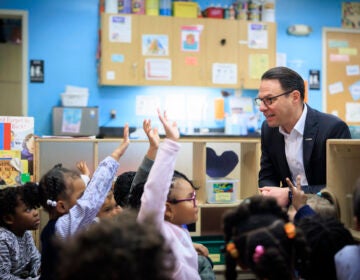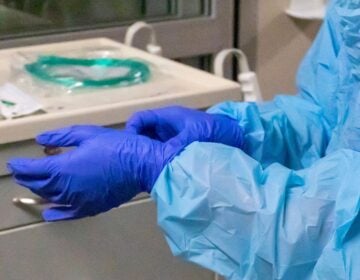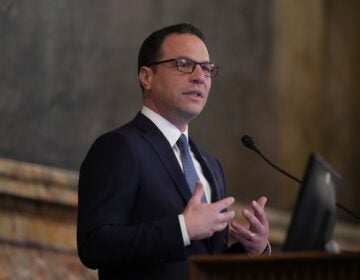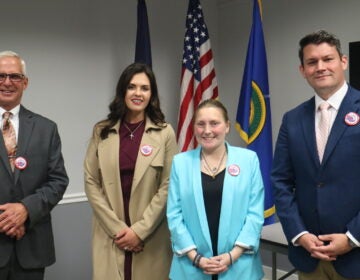Latest Pa. budget leaves embattled child care industry without much-needed funding to boost staffing
Low wages make it difficult for PA child care providers to hire and retain staff, which can lead to long wait lists and abrupt closures.
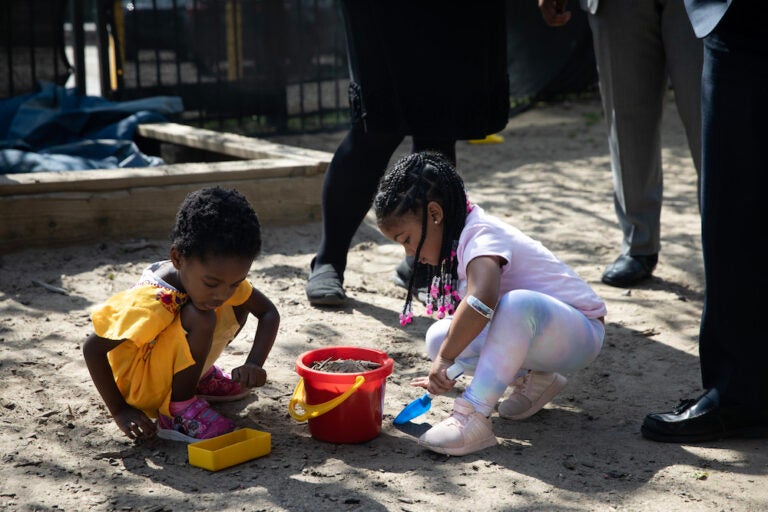
Children at Shady Lane School in Pittsburgh play in a sandbox. (Commonwealth Media Services)
This story originally appeared on Spotlight PA.
When Carli Viola-Luqa learned in April that her kid’s child care facility planned to permanently close, she panicked.
Viola-Luqa, a nurse, and her husband, a dentist, both work full time and have no family in Pennsylvania.
The couple, who live in suburban Pittsburgh, had depended on the early childhood center for more than 45 hours of care per week. While Viola-Luqa scrambled to find a new program with openings for her two toddlers, she teamed up with another mom to split caregiving duties and also hired a part-time nanny.
This temporary fix was not ideal. Viola-Luqa had to ask for a lot of flexibility from her job, which she started less than a year ago. She worried that her frequent requests for time off and the weird hours she was working reflected poorly on her as a new employee.
Viola-Luqa started having trouble sleeping and even considered sending her small children to stay with their grandparents in Canada until she found a permanent solution.
“I had tunnel vision. I felt like I couldn’t even make rational decisions. I was just being reactive,” Viola-Luqa said.
Many parents across Pennsylvania face similar predicaments. There simply aren’t enough child care providers, and advocates say the situation will get worse without help from the state.
Diane Barber, executive director of the Pennsylvania Child Care Association, said she knows of seven early childhood programs that have either closed or announced closures to come in the past month.
“We can open more child care, but there’s a reason those programs closed. Because
they couldn’t do it anymore. Because they couldn’t afford to do it anymore,” Barber said.
The problem, experts told Spotlight PA, is largely low wages, which make it difficult for child care programs to hire and retain staff. A May 2023 report from the U.S. Bureau of Labor Statistics found the mean annual income for a child care worker in Pennsylvania is $29,480, less than half of the mean wage for workers overall. For a preschool teacher, it’s $36,350.
As Viola-Luqa can attest, parents who lack child care can’t punch the clock. The business community says this issue significantly contributes to the workforce shortage.
In June, a coalition of more than 50 local chambers of commerce penned an open letter urging lawmakers to fund child care programs directly: “Providers just can’t compete in a labor market with many sectors offering $20+ per hour for largely unskilled positions.”
The business chambers also joined forces with child care advocates to campaign for a $284 million infusion of new and recurring state dollars, arguing the money would allow providers to increase workforce recruitment and retention efforts.
Despite the state’s $10.6 billion budget surplus, this push failed.
“We are very disappointed,” said Jen DeBell, the executive director of the Pennsylvania Association for the Education of Young Children.
The state did increase funding for child care services by $26 million. This bump primarily replaces a pandemic-era infusion from the federal government designed to stabilize the child care industry. Pennsylvania used the windfall to expand access to the Child Care Works program, which serves low-income families.
Child Care Works will also benefit from an additional $62 million increase in federal funds in 2025. But like other industries, child care providers — which include nonprofits and small businesses — are grappling with inflation. Advocates say the additional money will allow child care facilities to maintain the status quo, but does nothing to address the dearth of early childhood professionals.
In an emailed statement to How We Care, Manuel Bonder, a spokesperson for Democratic Gov. Josh Shapiro, wrote the administration is committed to adequately funding child care services for the sake of families and workers.
“We are the only state in the nation with a divided legislature, yet Governor Shapiro brought together both sides to deliver for the people of Pennsylvania. Compromise is a key part of any budget and while there’s always more work to do, this budget makes progress in the right direction and we will continue to work with advocates going forward,” Bonder said.
Pennsylvania Senate Majority Leader Joe Pittman (R., Indiana) shared similar sentiments with How We Care. In an email, he wrote the modest increase in child care funding represents a solid step forward.
“The final state budget strikes good compromise between a divided government and will help to both empower Pennsylvanians, and protect taxpayers in the years ahead,” Pittman said.
For several years, Harrisburg has attempted to alleviate the crisis by making care more affordable for families, either through the Child Care Works program or new tax credits.
Child care is certainly too expensive, said Emily Neff, the director of public policy for Trying Together — a Pittsburgh-based nonprofit that advocates for young children and caregivers. But tax credits for families won’t make a difference if providers aren’t accepting new kids.
“That’s where we often see, like, the empty classroom … but a program has a waiting list,” Neff said.
Low-income families enrolled in the subsidized Child Care Works program pay as little as $5 per week for care. The Pennsylvania Department of Human Services reports that 8,463 kids who qualify for Child Care Works are in what’s called “suspended status,” which means they are not currently attending a child care program.
The Pennsylvania Partnerships for Children says kids are usually in suspended status for provider reasons, including programs being at capacity.
As Shapiro has noted, the additional state and federal dollars going to Child Care Works will bring the subsidy up to the federally recommended level of 75% of what families pay in private tuition. But Barber says some providers will find this reimbursement rate is still too low and only accept children whose parents pay the full cost of care.
Also, in February 2023, Start Strong PA — a statewide coalition that advocates for affordable child care — surveyed Pennsylvania child care programs. Of the 1,082 that responded, 85% reported a staffing shortage.
Another survey conducted by the coalition from September 2023 reported that the 677 provider respondents would be able to care for an additional 16,527 children if they were fully staffed.
In the interim, families are figuring out arrangements on their own.
For Viola-Luqa and her husband, changes to their lifestyle and budget enabled them to enroll their son and daughter in a new child care program. She said it is much more expensive than their previous provider: Tuition for both kids is almost $3,000 a month — lunch and snacks not included.
To afford the program, they’re saving less money and not going out to eat as often or doing as many fun things. But Viola-Luqa said they’re lucky because not everyone can afford to pay so much.
Since her oldest was born in 2020, Viola-Luqa says she’s sent her kids to four different child care providers and this most recent one is by far the best-staffed.
“But, it comes at a cost,” she said.
 Spotlight PA is an independent, nonpartisan, and nonprofit newsroom producing investigative and public-service journalism that holds the powerful to account and drives positive change in Pennsylvania.
Spotlight PA is an independent, nonpartisan, and nonprofit newsroom producing investigative and public-service journalism that holds the powerful to account and drives positive change in Pennsylvania.

Get daily updates from WHYY News!
WHYY is your source for fact-based, in-depth journalism and information. As a nonprofit organization, we rely on financial support from readers like you. Please give today.


